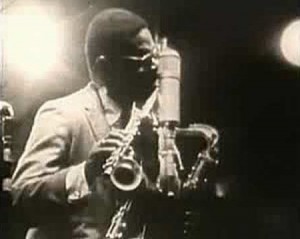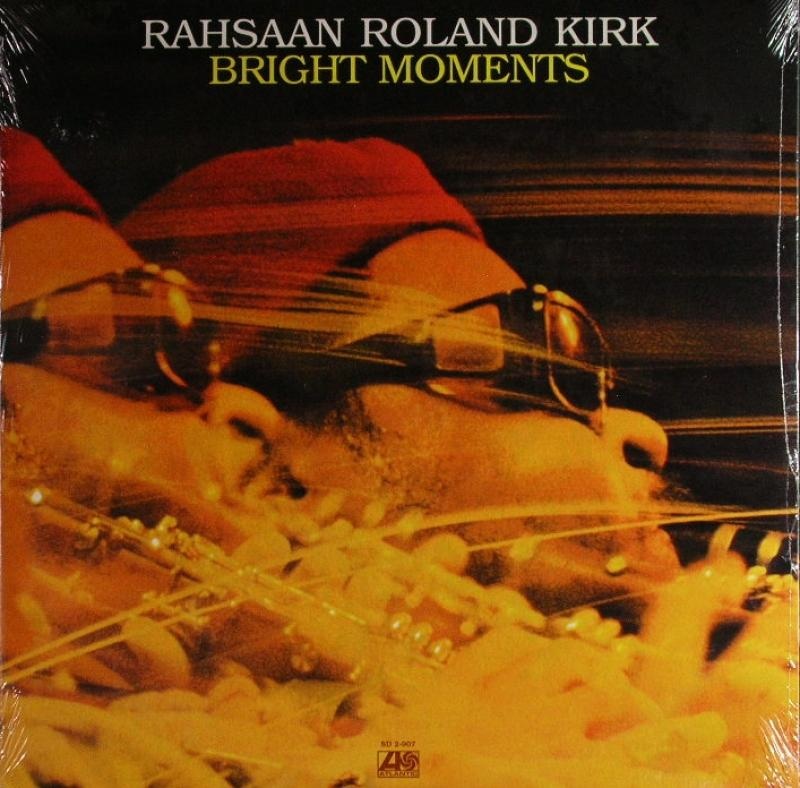 What is it like to live on the dream-alighted side of the eyes’ double threshold, all of the time? Is that what it means to be blind, as jazz saxophonist Rahsaan Roland Kirk was from an early age? Does the vigor or life force that enters the seeing eye as light, enter the blind man’s eye as a denser vibration, as sound, as nameless instinct, as a void veiled in the skin’s feeling? It is dangerous to romanticize what is often called a handicap, but from Blind Tom Wiggins, to Stevie Wonder, to Ray Charles, to Rahsaan, we must note the relentless correspondence between closed eyes and an open, mystic, highly advanced heart-mind, within the realm of Black Music. Does the imagination in these men bind to the astral world and make like a genie in the body until their every fantasy can manifest through an alternate sense, or extra sense, do vague entities feel tangible and every phantom substantial when light has to form through an inner alchemy in the body? Without the help of traditional seeing is the bridge between the vivid and the dim more a matter of will than of matter, does the invisible become accessible and edgeless within them, does the sun stand still in the bodies of blind men like on solstice days or as in a picturesque silhouette steadying the thought canvass with its ever-present, ever-vanishing flame? Do words and music serve as light forms, is sound their visual map? Is it everyone’s? I’ll admit I’d like to think so, that what we call blindness is actually a Heliocentric World populated by prophets and shamans, one we ourselves would be able to visualize if our imaginations and ears were finer tuned. Black music corroborates this hope.
What is it like to live on the dream-alighted side of the eyes’ double threshold, all of the time? Is that what it means to be blind, as jazz saxophonist Rahsaan Roland Kirk was from an early age? Does the vigor or life force that enters the seeing eye as light, enter the blind man’s eye as a denser vibration, as sound, as nameless instinct, as a void veiled in the skin’s feeling? It is dangerous to romanticize what is often called a handicap, but from Blind Tom Wiggins, to Stevie Wonder, to Ray Charles, to Rahsaan, we must note the relentless correspondence between closed eyes and an open, mystic, highly advanced heart-mind, within the realm of Black Music. Does the imagination in these men bind to the astral world and make like a genie in the body until their every fantasy can manifest through an alternate sense, or extra sense, do vague entities feel tangible and every phantom substantial when light has to form through an inner alchemy in the body? Without the help of traditional seeing is the bridge between the vivid and the dim more a matter of will than of matter, does the invisible become accessible and edgeless within them, does the sun stand still in the bodies of blind men like on solstice days or as in a picturesque silhouette steadying the thought canvass with its ever-present, ever-vanishing flame? Do words and music serve as light forms, is sound their visual map? Is it everyone’s? I’ll admit I’d like to think so, that what we call blindness is actually a Heliocentric World populated by prophets and shamans, one we ourselves would be able to visualize if our imaginations and ears were finer tuned. Black music corroborates this hope.
In 1975, Rahsaan made an album entitled The Case of the Three Sided Dream in Audio Color; an album that I take as an opus on the dynamic between looking and listening, between what’s keen and what’s kindred. Blindness, throughout the album, becomes a kind of dreaming, and dreaming becomes true sight, and then the medium through which a more precise mode of seeing is distributed, becomes sound, the voice: speech and music. And Rahsaan is pharaoh/king in the land, deliberating aloud with himself, bringing in the voice of Billie Holiday as she promises God Bless the Child that’s got his own and submerging it in his personal musings on non-duality and the idea and over-deification of technology— and in between these cinematic interludes he plays the flute, the tenor sax, the clarinet, the trumpet, the pharaoh rose, the cannibal and the sacrificed. It’s a brilliant album start to finish, the work of a man devoted to the arduous but beautiful task of letting his art introduce him to himself; a level of creativity that requires more than one medium as it seeks to access more than one piece of the spirit (both his and his audience’s), and so he recites voice poetry throughout this Dream, as well as blowing every horn into a thought form.
It’s a brilliant album start to finish, the work of a man devoted to the arduous but beautiful task of letting his art introduce him to himself; a level of creativity that requires more than one medium as it seeks to access more than one piece of the spirit…and so he recites voice poetry throughout this Dream, as well as blowing every horn into a thought form.
My first encounter with this work, came through a splice of speech that Hip Hop producer Madlib sampled on his one man jazz trio Yesterday’s New Quintet’s tribute to Stevie Wonder. Fittingly as the intro to his instrumental version of Stevie’s That Girl, there’s this oracle of gibberish and epiphany … In that we all know there will never be peace… I’d like to say brightmoments and joy through the universe to all the very beautiful people who might take their time out to listen to this beautiful piece of spinning material that is in their presence… that’s the start of it… Brightmoments, and joy, because we know that the whole thing of peace has passed us all by, the voice elaborates, as the beat drops.
Audio Player
 This fractal/poem/ poignant epiphany haunted me in the best way for a couple of years until I met the man, the myth behind that sample and asked him to tell me its source. He revealed with aloof candor, that’s Rahsaan Roland Kirk. And I didn’t pry much further because I was sure it must have been on some rare interview or radio spot, just reminded the mythscientist behind YNQ why he’s one of my favorite poets and changed the subject. It wasn’t until a few months later that a good friend of mine, who is also dj and record collector, hit me up on gchat, as we tend to do in this day and age, to announce the news. He had fallen asleep listening to the Rahsaan Roland Kirk’s Case of the Three Sided Dream in Audio Color and about forty minutes into the fuzzy silence at the end of the record a voice emerged … In that we all know that there will never be peace.. rousing him from his own dream. There was the sample, the 4th dimension of Rahsaan’s Three-Sided Dream. With this discovery so much cherish welled up in my heart I felt like embracing the air, a real hoodrich frolic sprung up in me and I think, though I wasn’t aware of it at the time, that a significant amount of my archive fever was born right then. The thought of being able to listen to jazz, one of my true, innate loves, and discover what I consider poetry, the more stable marrying kind of discipline I could never fully commit to without jazz in the background casting its gauzy irresistible nets around the rhythms in the omniverse; the idea of engaging the two of them at once, of finding these hidden spheres wherein music and poetic diction were already one gallant being, changed my life really, gave my two loves a mutually deepening meaning, justified my promiscuous relationship with the arts and disbelief in this Western construct we call genre.
This fractal/poem/ poignant epiphany haunted me in the best way for a couple of years until I met the man, the myth behind that sample and asked him to tell me its source. He revealed with aloof candor, that’s Rahsaan Roland Kirk. And I didn’t pry much further because I was sure it must have been on some rare interview or radio spot, just reminded the mythscientist behind YNQ why he’s one of my favorite poets and changed the subject. It wasn’t until a few months later that a good friend of mine, who is also dj and record collector, hit me up on gchat, as we tend to do in this day and age, to announce the news. He had fallen asleep listening to the Rahsaan Roland Kirk’s Case of the Three Sided Dream in Audio Color and about forty minutes into the fuzzy silence at the end of the record a voice emerged … In that we all know that there will never be peace.. rousing him from his own dream. There was the sample, the 4th dimension of Rahsaan’s Three-Sided Dream. With this discovery so much cherish welled up in my heart I felt like embracing the air, a real hoodrich frolic sprung up in me and I think, though I wasn’t aware of it at the time, that a significant amount of my archive fever was born right then. The thought of being able to listen to jazz, one of my true, innate loves, and discover what I consider poetry, the more stable marrying kind of discipline I could never fully commit to without jazz in the background casting its gauzy irresistible nets around the rhythms in the omniverse; the idea of engaging the two of them at once, of finding these hidden spheres wherein music and poetic diction were already one gallant being, changed my life really, gave my two loves a mutually deepening meaning, justified my promiscuous relationship with the arts and disbelief in this Western construct we call genre.
The experience of locating the Brightmoments hidden in a dream sequence was its own dream sequence that made clear to me that to be a black artist is to help build the black archive, to help reconstruct the Black Ark, and not always in some formal, heady, self-congratulating way; whatever way we can really. If that means we have to make the sun stand still on the third eye because the other two are preoccupied, if that’s what it takes to climb to the healing paradox without parody or excess pride, and to preserve our culture heritage, ancient to the future, in that we all know that there will never be peace, then that’s what we’ll do, with joy, with jive, high on heliocentric jazz/poems, and justice.
Harmony Holiday is a poet and a choreographer. You can check out her work on the AfroSonics Archive here. For more detailed coverage of the archive and specially curated objects and ephemera related to it, check out: http://www.fenceportal.org/?

